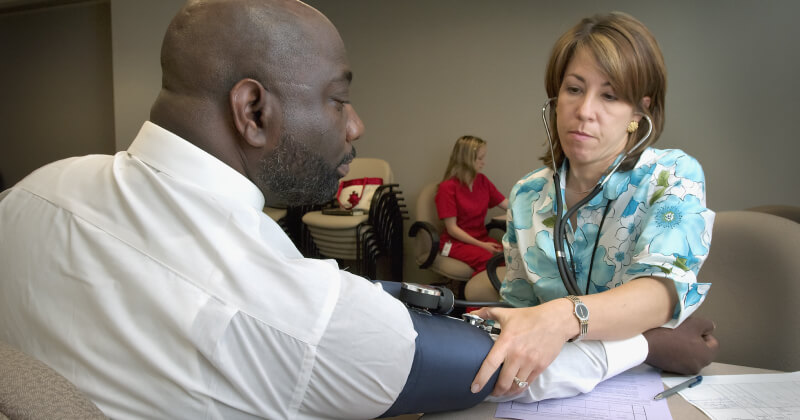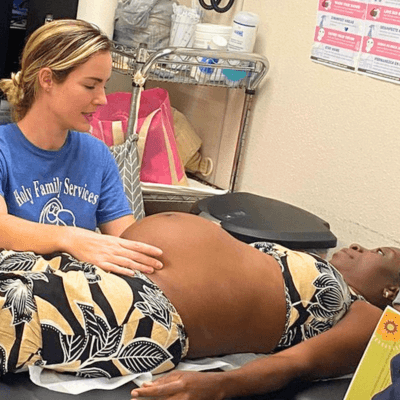Long COVID and Historically Marginalized Patients: Amplified Risks Require a Different Approach

[Editor's Note: The Spring issue of Streamline reached mailboxes across the United States a few weeks ago. Here, we reprint one featured article. On our Streamline webpage, you can read the entire issue, with articles on diabetes management during disasters; care coordination for pregnant asylum seekers; sexual violence in the fields and at home during COVID; and MCN's diabetes comic book translated into English. You can also access archived issues and sign up to receive future issues of the in-print quarterly publication.]
Despite over two years of data on COVID-19, it remains unclear what percentage of people who contract COVID-19 develop symptoms of long COVID in the weeks or months after their acute illness. Also known as long-haul COVID and cited in medical literature as Post-Acute Coronavirus Disease Syndrome (PACS) or Post-Acute Sequelae of SARS-CoV-2 (PASC), long COVID may affect between 10 and 30% of people who had COVID, or possibly more. But what is long COVID, and what do clinicians need to know about long COVID when considering the needs of their migrant, immigrant, asylum-seeking, and agricultural worker patients? Amid the rapidly accumulating and changing data, several key findings are relevant for these special populations.
Long COVID symptoms vary
Long COVID can be defined as either the experience of symptoms after an acute COVID-19 infection has resolved, or the symptoms that develop a month or more after infection. They may also be symptoms that a patient experienced during acute infection that never fully resolved. Long COVID affects individuals in dramatically different ways, likely because COVID can affect all organ systems and consequently has multiorgan effects, including on the functioning of the heart, lungs, kidneys, skin, and brain1. While over 200 different symptoms have been identified,2 the Centers for Disease Control and Prevention (CDC) have outlined some of the more commonly reported symptoms:3
- Difficulty breathing or shortness of breath
- Tiredness or fatigue
- Symptoms that get worse after physical or mental activities (also known as post-exertional malaise)
- Difficulty thinking or concentrating (sometimes referred to as “brain fog”)
- Cough
- Chest or stomach pain
- Headache
- Fast-beating or pounding heart (also known as heart palpitations)
- Joint or muscle pain
- Pins-and-needles feeling
- Diarrhea
- Sleep problems
- Fever
- Dizziness on standing (lightheadedness)
- Rash
- Mood changes
- Change in smell or taste
- Changes in menstrual period cycles
Many factors appear to influence what symptoms of long COVID one may experience, including severity of acute infection, age, sex, comorbidities, length of time since infection, and even the variant that the patient contracted.
Patients who were hospitalized with COVID are most likely to experience long COVID,4 but those who contracted a very mild case of COVID may still suffer with symptoms, months later. Even those who were asymptomatic during their COVID infection may experience long COVID.5 Symptoms may appear directly after infection or may be delayed; one large study found that 39.9% of long COVID sufferers stated that their symptom or symptoms began more than 90 days after initial infection.6 Women suffer from long COVID more than men,7 and certain comorbidities make a patient more likely to experience long COVID. (See “Long COVID may affect people with certain comorbidities more than others,” below.)
Additionally, long COVID symptoms may differ according to what COVID variant the patient contracted. A recent study determined that cognitive impairment (or “brain fog”), difficulty breathing, and muscle pain were more associated with infections early in the pandemic, when the alpha variant was dominant.8 More data are needed to understand the causal relationship between various symptoms and COVID-19 variants, but the study demonstrates that as our knowledge of long COVID continues to grow, our understanding of the factors determining its likelihood and severity grow as well.
Long COVID and health inequities
People of color in the US have experienced higher rates of hospitalization and death from acute COVID-19, compared to white populations.9 The CDC notes that “both historical and current experiences of racism and discrimination contribute to mistrust of the health care system among racial and ethnic minority groups.”10
Many studies describe the numerous health disparities that non-white people have faced during the COVID-19 pandemic. These disparities existed before COVID, were exacerbated during the pandemic, have continued, and may result in inequities in long COVID, as well. Disparities include poverty, lack of health insurance, living in rural and medically underserved areas, and also structural inequalities like discrimination, racism, and a lack of occupational protection.11 Agricultural workers, migrants, and immigrants face significant structural racism and these health inequities, both of which prevent them from successfully accessing quality health care, including for issues around long COVID.
Long COVID affects the heart
Researchers in a recent study published in Nature Medicine found that the risk of cardiovascular events after even a mild case of COVID is substantial.12 More data are needed to understand the mechanisms by which COVID affects the heart; early theories include entrance via ACE2 receptors and damage to arteries. Regardless of how, the evidence is strong that it can substantially damage the heart. Their research, using national health care databases from the US Department of Veteran Affairs, demonstrates that, beyond the first 30 days after COVID infection, individuals have a higher risk of diverse heart concerns including stroke, heart attack, and myocarditis. The risk is related to the severity of the acute infection; for example, the risk for stroke among non-hospitalized patients after COVID infection was 23% higher, compared to 425% higher among hospitalized patients.
For patients who encounter numerous barriers to health care including migration, rural locations, transportation issues, lack of health insurance, linguistic barriers, and more, it is critical to share the increased risk and the signs and symptoms of cardiovascular disease, as well as information on when to seek care. Younger and otherwise healthy patients who have recovered from COVID may not seem at risk for cardiovascular disease; these patients, too, should be informed of their increased risk and what to look for.
Long COVID may affect people with certain comorbidities more than others
Diabetes and asthma have both been linked to long COVID. Diabetes and acute COVID have already been strongly linked, including a study that found that people who tested positive to COVID-19 have a higher likelihood of a diabetes diagnosis in the following months than those who tested negative.13 More recently, a study found that those who contract COVID-19 and have a diagnosis of diabetes are more likely to suffer from long COVID.14 Diabetes rates among agricultural workers are higher than the general population,15 leading to increased risk of long COVID.
Asthma may also increase a person’s risk of long COVID. Occupational exposure to pesticides and agricultural dust may increase agricultural workers’ risk of asthma,16 although diagnoses among US agricultural workers remain low.17 One study found that 56% of COVID patients with asthma reported suffering from long COVID, including breathing difficulties.18
Vaccination may prevent long COVID
A vaccinated person has a much lower risk of contracting COVID, and a very low risk of severe disease or death from COVID. As stated above, those who are hospitalized or have a more severe form of acute COVID have a higher risk of long COVID.19 Consequently, vaccination is a critical component to reduce one’s risk of long COVID.
Treatment guidance is starting to become available
The American Academy of Physical Medicine and Rehabilitation has developed several guidance statements to assist clinicians in assessing and treating patients with long COVID with symptoms of fatigue, breathing difficulties, and cognitive symptoms. They also have a dashboard on long COVID and a comprehensive resource list: https://www.aapmr.org/members-publications/covid-19/physiatrist-resource-center/long-covid-pasc-resources
The CAMFiC Long COVID-19 Study Group has proposed primary care clinical guidelines, suggesting three primary care visits over the course of 14 weeks. Their guidance includes diagnostic approaches to each of the most common symptoms of long COVID. “Long Covid-19: Proposed Primary Care Clinical Guidelines for Diagnosis and Disease Management”:
https://www.ncbi.nlm.nih.gov/pmc/articles/PMC8073248/
Read the full article on cardiovascular events and risks from Nature Medicine: https://go.nature.com/3jakPaW
References
1 Centers for Disease Control and Prevention. Post-COVID Conditions. Updated 16 September 2021. Available at: https://www.cdc.gov/coronavirus/2019-ncov/long-term-effects/index.html
2 Davis HE, Assaf GS, McCorkell L, et al. Characterizing long COVID in an international cohort: 7 months of symptoms and their impact. EClinicalMedicine. 2021;38:101019. doi:10.1016/j.eclinm.2021.101019
3 Centers for Disease Control and Prevention. Post-COVID Conditions. 16 September 2021. Available at: https://www.cdc.gov/coronavirus/2019-ncov/long-term-effects/index.html
4 Pérez-González A, Araújo-Ameijeiras A, Fernández-Villar A, Crespo M, Poveda E; Cohort COVID-19 of the Galicia Sur Health Research Institute. Long COVID in hospitalized and non-hospitalized patients in a large cohort in Northwest Spain, a prospective cohort study. Sci Rep. 2022;12(1):3369. Published 2022 Mar 1. doi:10.1038/s41598-022-07414-x
5 Belluck P. Many ‘Long Covid’ Patients Had No Symptoms From Their Initial Infection. New York Times. Published 8 March 2021. Available at: https://www.nytimes.com/2021/03/08/health/long-covid-asymptomatic.html
6 Taquet M, Dercon Q, Luciano S, Geddes JR, Husain M, Harrison PJ. Incidence, co-occurrence, and evolution of long-COVID features: A 6-month retrospective cohort study of 273,618 survivors of COVID-19. PLoS Med. 2021;18(9):e1003773. Published 2021 Sep 28. doi:10.1371/journal.pmed.1003773
7 Stewart S, Newson L, Briggs TA, Grammatopoulos D, Young L, Gill P. Long COVID risk - a signal to address sex hormones and women's health. Lancet Reg Health Eur. 2021;11:100242. doi:10.1016/j.lanepe.2021.100242
8 European Congress of Clinical Microbiology & Infectious Diseases. Different SARS-CoV-2 variants may give rise to different long COVID symptoms, study suggests. News Release 24 March 2022. Available at: https://www.eurekalert.org/news-releases/947495
9 Centers for Disease Control and Prevention. COVID-19: Health Equity Considerations & Racial & Ethnic Minority Groups. Updated 25 January 2022. Available at: https://www.cdc.gov/coronavirus/2019-ncov/community/health-equity/race-ethnicity.html#:~:text=Impact%20of%20Racial%20Inequities%20on%20Our%20Nation's%20Health,-Racism%2C%20either%20structural&text=COVID%2D19%20data%20shows%20that,with%20non%2DHispanic%20White%20populations.
10 Ibid.
11 Berger Z, Altiery DE Jesus V, Assoumou SA, Greenhalgh T. Long COVID and Health Inequities: The Role of Primary Care. Milbank Q. 2021;99(2):519-541. doi:10.1111/1468-0009.12505
12 Xie Y, Xu E, Bowe B, Al-Aly Z. Long-term cardiovascular outcomes of COVID-19. Nat Med. 2022;28(3):583-590. doi:10.1038/s41591-022-01689-3
13 Hernandez-Romieu AC, Carton TW, Saydah S, et al. Prevalence of Select New Symptoms and Conditions Among Persons Aged Younger Than 20 Years and 20 Years or Older at 31 to 150 Days After Testing Positive or Negative for SARS-CoV-2. JAMA Netw Open. 2022;5(2):e2147053. Published 2022 Feb 1. doi:10.1001/jamanetworkopen.2021.47053
14 Su Y, Yuan D, Chen DG, et al. Multiple early factors anticipate post-acute COVID-19 sequelae. Cell. 2022;185(5):881-895.e20. doi:10.1016/j.cell.2022.01.014
15 National Center for Farmworker Health, Inc. Diabetes & U.S. Agricultural Workers. 2014. Available at: http://www.ncfh.org/uploads/3/8/6/8/38685499/fs-diabetes.pdf
16 Rao P and Davis S. Topics in Respiratory Health of Farmworkers. Farmworker Justice. 2008. Available at: https://www.farmworkerjustice.org/wp-content/uploads/2012/08/Topics-in-Respiratory-Health-of-Farmworkers.pdf
17 Arroyo AJC, Robinson LB, Downing NL, Camargo CA Jr. Occupational exposures and asthma prevalence among US farmworkers: National Agricultural Workers Survey, 2003-2014. J Allergy Clin Immunol Pract. 2018;6(6):2135-2138.e2. doi:10.1016/j.jaip.2018.03.006
18 Philip KEJ, Buttery S, Williams P, et al. Impact of COVID-19 on people with asthma: a mixed methods analysis from a UK wide survey. BMJ Open Respir Res. 2022;9(1):e001056. doi:10.1136/bmjresp-2021-001056
19 Venkatesan P. Do vaccines protect from long COVID?. Lancet Respir Med. 2022;10(3):e30. doi:10.1016/S2213-2600(22)00020-0
Got some good news to share? Contact us on our social media pages above.
Return to the main blog page or sign up for blog updates here.
- Log in to post comments






